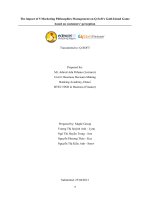Business Decision Making Assignment 1
Bạn đang xem bản rút gọn của tài liệu. Xem và tải ngay bản đầy đủ của tài liệu tại đây (972.9 KB, 42 trang )
Nguyễn Thị Kiều Anh - Snow - F05014
BTEC
BANKING ACADEMY OF VIETNAM
HND IN BUSINESS (ACCOUNTING)
ASSIGNMENT COVER SHEET
NAME OF STUDENT
REGISTRATION NO.
UNIT TITLE
ASSIGNMENT TITLE
ASSIGNMENT NO
NAME OF ASSESSOR
SUBMISSION DEADLINE
Nguyễn Thị Kiều Anh - Snow - F05A
F05-014
Unit 6: Business Decision Making
Forecasting Techniques and Business Decisions
2 of 2
Jubred A. Peñano
June 13th, 2013
I, ______Nguyễn Thị Kiều Anh________ hereby confirm that this assignment is my own work and not copied
or plagiarized from any source. I have referenced the sources from which information is obtained by me for this
assignment.
________________________________
Signature
_______13th June, 2013__________
Date
---------------------------------------------------------------------------------------------------------------------
FOR OFFICIAL USE
Assignment Received By:
Date:
1
Nguyễn Thị Kiều Anh - Snow - F05014
Unit Outcomes
Learning
Outcomes
Be able to
produce
information in
appropriate
formats for
decision making
in an
organisational
context
LO3
Be able to use
software –
generated
information to
make decisions in
an organisation
Evidence for the
criteria
Feedback
Assessor’s
decision
Produce graphs using
spreadsheets and draw
valid conclusions
based on the
information derived
3.1
Create trend lines in
spreadsheet graphs to
assist in forecasting for
specified business
information
3.2
Prepare a business
presentation using
suitable software and
techniques to
disseminate
information effectively
3.3
Produce a formal
business report
3.4
Use appropriate
information processing
tools
4.1
Prepare a project plan
for an activity and
determine the critical
path
4.2
Use financial tools for
decision making
4.3
Internal
Verification
LO4
Merit grades awarded
M1
M2
M3
Distinction grades awarded
D1
D2
D3
2
Nguyễn Thị Kiều Anh - Snow - F05014
Learning
Outcomes
Evidence for the
criteria
Feedback
Assessor’s
decision
Internal
Verification
Assignment
( ) Well-structured; Reference is done properly / should be done (if any)
Overall, you’ve
Areas for improvement:
ASSESSOR SIGNATURE
DATE
/
/
DATE
/
/
NAME:.........................................................................................
(Oral feedback was also provided)
STUDENT SIGNATURE
NAME :..............................................................................
FOR INTERNAL USE ONLY
VERIFIED
YES
NO
DATE
: ...........................................................................
VERIFIED BY : ...........................................................................
NAME
: ...........................................................................
3
Nguyễn Thị Kiều Anh - Snow - F05014
FORECASTING TECHNIQUES AND BUSINESS DECISIONS
Prepared for:
Mr. Jubred Ada Peñano (Lecturer)
Unit 6: Business Decision Making
Banking Academy, Hanoi
BTEC HND in Business (Finance)
Prepared by:
Nguyễn Thị Kiều Anh – Snow - F05A
Registration No: ITP F05-014
Submission date: 13th June 2013
4
Nguyễn Thị Kiều Anh - Snow - F05014
TABLE OF CONTENTS
EXECUTIVE SUMMARY
This assignment contains basic knowledge about business decision making as well as help
learner understand way to use techniques and method for calculating and forecasting as well
as giving decision in specific situations. It consists of 4 main tasks as follows:
•
Task 1: Forecasting Techniques
By using 3 methods namely least square, additive model and proportional model, CMI
can forecast sales in next year and make best decision in order to maximize
profitability.
•
Task 2: Management Information System (MIS)
Based on 3 levels of management including strategic management, tactical
management and operational management, CMI can select information system which
suitable for each department of CMI to improve the company performance and run
business effectively.
•
Task 3: Project plan
Help learner understand the operational processes and techniques associated with
project management and know way to plan a project and draw up a work breakdown
structure.
•
Task 4: Investment Appraisal Techniques
5
Nguyễn Thị Kiều Anh - Snow - F05014
By using financial tools such as NPV and IRR to evaluate the potential project and
proposed investment, the company can make decision whether should choose which
project to invest brings more benefit for company.
INTRODUCTION
CMI is a world-renowned manufacturer of private label, custom-made formulations and
products, including skin care, hair care, body care, colour cosmetics, pharmaceuticals.
Company’s state-of-the-art facilities and highly motivated staff of professionals set us apart
from their competitors in the cosmetics industry. CMI offer many specialize services
including: Clinical and scientific studies, comprehensive research and development, high
production capacity, bulk products… (CMI, n.d)
This report will show the methods, techniques such as forecasting methods, project plan, and
investment appraisal techniques to forecast sales, identify suitable project for investment…
Forecasting method will help company forecast actual sales in year 2012. There are 3
methods: least square, additive model and proportional model to help company understand
advantage and disadvantage of each method for using appropriate methods. Investment
appraisal techniques support company making decision in investment, analysis based on NPV
and IRR. Moreover, CMI will be suggested for using MIS instead of paper-driven system to
improve company performance.
6
Nguyễn Thị Kiều Anh - Snow - F05014
Task 1: Forecasting Techniques
1.
Additive model
The formula for additive model for time series analysis is Y = T + S + R
Where Y is value of the changing valuable which is the actual volume of sale
T is trend
S is seasonal variation
R is residual component
Assuming the residual component is 0 the seasonal component is S = Y - T
The season variation for 6 year 2006, 2007, 2008, 2009, 2010 and 2011 is as follows:
Year Quarter
2006
2007
2008
2009
1
2
Actual volume
of sales
(Y)
500
350
3
4
1
2
3
4
1
2
3
4
1
250
400
450
350
200
300
350
200
150
400
550
ADDITIVE MODEL
Moving total of
Moving
4 quarters’
average of 8
sales
quarters’ sales
1,500
1,450
1,450
1,400
1,300
1,200
1,050
1,000
1,100
1,300
1,450
2,950
2,900
2,850
2,700
2,500
2,250
2,050
2,100
2,400
2,750
3,000
Trend
(T)
Seasonal
variation
(Y-T)
368.75
362.50
356.25
337.50
312.50
281.25
256.25
262.50
300.00
343.75
375.00
-118.75
+37.50
+93.75
+12.50
-112.50
+18.75
+93.75
-62.50
-150.00
+56.25
+175.00
7
Nguyễn Thị Kiều Anh - Snow - F05014
2010
2011
2
3
4
1
2
3
4
1
2
3
4
350
250
550
550
400
350
600
750
500
400
650
1,550
1,700
1,700
1,750
1,850
1,900
2,100
2,200
2,250
2,300
3,250
3,400
3,450
3,600
3,750
4,000
4,300
4,450
4,550
406.25
425.00
431.25
450.00
468.75
500.00
537.50
556.25
568.75
-56.25
-175.00
+118.75
+100.00
-68.75
-150.00
+62.50
+193.75
-68.75
Table 1.1.1: Applying additive model on the sales of CMI’s skin care cream from 2006 to 2011
2006
2007
2008
2009
2010
2011
Total
Average
Adjustment to reduce ~
total variation to 0
Final estimate of average
quarterly variation
Quarter 1
Quarter 2
Quarter 3
-118.75
-112.50
-150.00
-175.00
-150.00
Quarter 4
+37.50
+18.75
+56.25
+118.75
+62.50
+93.75
+93.75
+175.00
+100.00
+193.75
+656.25
+131.25
+12.50
-62.50
-56.25
-68.75
-68.75
-243.75
-48.75
0
+131.25
Total
-706.25
-141.25
293.75
+58.75
0
0
0
0
0
-48.75
-141.25
+58.75
0
Table 1.1.2: The summary and average of seasonal variations
The average seasonal estimates must therefore be corrected so that they add up to zero.
Average seasonal variations (in £000’s) from Quarter 1 to Quarter 4 are +131.25 (Quarter
1), -48.75 (Quarter 2), -141.25 (Quarter 3) and +58.75 (Quarter 4).
The trend line indicates an increase of about 10.5263 per quarter. This can be confirmed by
calculating the average quarterly increase in trend line values between the third quarter of
Year 2006 (468.75) and the second quarter of Year 2011 (368.75).
The average rise is:
Taking as 10.5263 as the quarterly increase in the trend, the forecast of sales for Year 2012,
before seasonal adjustment (the trend line forecast) would be as follows:
8
Nguyễn Thị Kiều Anh - Snow - F05014
Table 1.1.3: The trend line forecast in year 2012
Seasonal variation should now be incorporated to obtain the final forecast:
Ye
ar
Quar
ter
1
201
2
2
3
4
Trend
line
forecast
600.328
9
610.855
2
621.381
5
631.907
8
Adjustment
average
variation
+131.25
Forecast actual
of sale
(in £’000s)
731.5789
-48.75
562.1052
-141.25
480.1315
+58.75
690.6578
Tot
al
2464.47
Table 1.1.4: The forecast of actual sale of CMI for year 2012
With an average variation for Quarter 1 of +131.25, the prediction for first quarter of year
2012 would have been 600.3289 + (+131.25) = 731.5789. Calculate the same for remaining
quarter of year 2012.
By using the additive method, the sales in year 2012 is forecasted about £2,464,470.
We have chart for sales from year 2006 to year 2012:
Chart 1.1: The line graph of additive method for 7 years selling skin care cream
Explanation: The method is to use the differences between the trend (T) and actual data (Y).
This forecasting method basically relies on the time series analysis. The model for time series
as Y = T + S + R (with stands for the seasonal variation; R stands for the residual
component). Extrapolation forecasting techniques is used by extending a trend line outside
the range of known data to forecast the future from a trend line which based on historical
data. Therefore, firstly, we have to calculate a trend line using moving averages, and then
values by the average seasonal variation applicable to the future period. Because this method
only simply adds absolute and unchanging seasonal variations to the trend figures; therefore
using the additive model to forecast sales is less accurate this effects significant on making
business decision of the company.
9
Nguyễn Thị Kiều Anh - Snow - F05014
2.
Proportional model
The formula for proportional model for time series analysis is Y = T × S × R
Where Y is value of the changing valuable which is the actual volume of sale
T is trend
S is seasonal variation
R is residual component
Assuming the residual component is 0 the seasonal component is S =Y/T
Year
2006
2007
2008
2009
2010
2011
The season variation for 6 year 2006, 2007, 2008, 2009, 2010 and 2011 is as follows
PROPORTIONAL MODEL
Quarter Actual volume Moving total of
Moving
Trend
Seasonal
of sales
4 quarters’
average of 8
(T)
percentage
(Y)
sales
quarters’ sales
(Y/T)
1
500
2
350
3
250
1,500
2,950
368.75
0.6780
4
400
1,450
2,900
362.50
1.1034
1
450
1,450
2,850
356.25
1.2632
2
350
1,400
2,700
337.50
1.0370
3
200
1,300
2,500
312.50
0.6400
4
300
1,200
2,250
281.25
1.0667
1
350
1,050
2,050
256.25
1.3659
2
200
1,000
2,100
262.50
0.7619
3
150
1,100
2,400
300.00
0.5000
4
400
1,300
2,750
343.75
1.1636
1
550
1,450
3,000
375.00
1.4667
2
350
1,550
3,250
406.25
0.8615
3
250
1,700
3,400
425.00
0.5882
4
550
1,700
3,450
431.25
1.2754
1
550
1,750
3,600
450.00
1.2222
2
400
1,850
3,750
468.75
0.8533
3
350
1,900
4,000
500.00
0.7000
4
600
2,100
4,300
537.50
1.1163
1
750
2,200
4,450
556.25
1.3483
2
500
2,250
4,550
568.75
0.8791
3
400
2,300
4
650
Table 1.2.1: Applying proportional model on the sale of CMI’s skin care cream from 2006 to 2011
2006
2007
Quarter 1
(%)
Quarter 2
(%)
1.2632
1.0370
Quarter 3
(%)
0.6780
0.6400
Quarter 4
(%)
1.1034
1.0667
Total
10
Nguyễn Thị Kiều Anh - Snow - F05014
2008
2009
2010
2011
Total
Average
Adjustment to add up ~
total variation to 4
Final estimate of average
quarterly variation
1.3659
1.4667
1.2222
1.3483
6.6663
1.3333
0.7619
0.8615
0.8533
0.8791
4.3928
0.8786
0.5000
0.5882
0.7000
1.1636
1.2754
1.1163
3.1062
0.6212
5.7254
1.1451
3.9782
0.00545
0.00545
0.00545
0.00545
0.0218
1.33875
0.88405
0.62665
1.15055
4
Table 1.2.2: The summary and average of seasonal variations
Instead of summing to zero, as with this approach, these should sum (in this case) to 4. They
actually sum to 3.9782 so 0.00545 has to be deducted from each one.
Average seasonal variations (in £000’s) from Quarter 1 to Quarter 4 are 1.33875 (Quarter
1), 0.88405 (Quarter 2), 0.62665 (Quarter 3) and 1.15055 (Quarter 4)
The trend line indicates an increase of about 10.5263 per quarter. This can be confirmed by
calculating the average quarterly increase in trend line values between the third quarter of
Year 2006 (468.75) and the second quarter of Year 2011 (368.75).
The average rise is:
Taking as 10.5263 as the quarterly increase in the trend, the forecast of sales for Year 2012,
before seasonal adjustment (the trend line forecast) would be as follows:
Table 1.2.3: The trend line forecast in year 2012
Seasonal variation should now be incorporated to obtain the final forecast:
Ye
ar
Quar
ter
201
2
1
2
3
4
Tot
al
Trend
line
forecast
600.3289
610.8552
621.3815
631.9078
Adjustment average
seasonal percentage
variation (%)
1.33875
0.88405
0.62665
1.15055
Forecast actual
of sale
(in £’000s)
803.6903
540.0265
389.3887
727.0415
2460.147
Table 1.2.4: The forecast of actual sale of CMI for year 2012
11
Nguyễn Thị Kiều Anh - Snow - F05014
With an average variation for Quarter 1 of 1.33875, the prediction for first quarter of year
2012 would have been 600.3289 × 1.33875 = 803.6930. Calculate the same for remaining
quarter of year 2012.
By using the proportional/multiplicative model method, the sales in year 2012 is
forecasted about £2,460,147.
We have chart for sales from 2006 to 2012:
Chart 1.2: The line graph of multiplicative method for 7 years selling skin care cream
Explanation: The model for time series as Y = T × S × R so similarly as the additive model
in calculating the actual result (Y) and the moving average (T), however, in this case we
calculate S = Y/T for the proportional model instead of S = Y - T. In order word, with
additive model, add (or subtract for negative variations) the variation while with the
multiplicative model, multiply the trend value by the variation proportion. By using the
proportional/multiplicative model method, the sales in year 2012 is forecasted about
£2,460,147. The multiplicative model, by multiplying increasing or decreasing trend values
by a constant seasonal variation factor, takes account of changing seasonal variations;
therefore, using the additive model to forecast sales is better and more exact than additive
model This method have effect positively on making business decision of company.
3.
Least squares regression method
LEAST SQUARES
12
Nguyễn Thị Kiều Anh - Snow - F05014
Yea
rs
200
6
200
7
200
8
200
9
201
0
201
1
Tot
al
Quarte
rs
1
x
y
xy
0
500
0
0
2
1
350
350
1
3
4
2
3
250
400
500
1,200
4
9
1
4
450
1,800
16
2
5
350
1,750
25
3
4
1
6
7
8
200
300
350
1,200
2,100
2,800
36
49
64
2
3
4
9
10
11
200
150
400
1,800
1,500
4,400
81
100
121
1
12
550
6,600
144
2
13
350
4,550
169
3
4
14
15
250
550
3,500
8,250
196
225
1
16
550
8,800
256
2
17
400
6,800
289
3
18
350
6,300
324
4
19
600
361
1
20
750
2
21
500
3
22
400
11,40
0
15,00
0
10,50
0
8,800
4
23
650
529
276
9,800
14,95
0
124,8
50
400
441
484
4,324
250,00
0
122,50
0
62,500
160,00
0
202,50
0
122,50
0
40,000
90,000
122,50
0
40,000
22,500
160,00
0
302,50
0
122,50
0
62,500
302,50
0
302,50
0
160,00
0
122,50
0
360,00
0
562,50
0
250,00
0
160,00
0
422,50
0
4,525,0
00
Table 1.3.1: Applying least square method on the sales of skin care cream of CMI
We have x = 0 is in quarter 1 of 2006, x = 1 is in quarter 2 of 2006 and so on to x = 23.
n is the number of pairs data so n = 24
13
Nguyễn Thị Kiều Anh - Snow - F05014
The least squares line uses a straight line which has the form: y = a + bx
With y: sales of skin care cream (in £1,000s)
x: time
a: the intercept of the line on the vertical axis
b: the gradient of the line
n: the number of pairs of data
Therefore, y = 286.9335 + 10.5652x
Predicting forecast daily sales in year 2012 would be:
Quarter 1: y = 286.9335 + 10.5652 × 24 = 540.4983
Quarter 2: y = 286.9335 + 10.5652 × 25 = 551.0635
Quarter 3: y = 286.9335 + 10.5652 × 26 = 561.6287
Quarter 4: y = 286.9335 + 10.5652 × 27 = 572.1939
According that, we have the table to calculate the forecast actual daily sales in year 2012 as
follow:
Forecast actual sales
Year
Quarter
£000’s
2012
s
1
2
3
4
Total
540.4983
551.0635
561.6287
572.1939
2225.384
Table 1.3.2: The forecast actual sales in year 2012 of CMI
By using least square method, the sales forecast for the year 2012 will be about
£2,225,384.
We have chart for sales from year 2006 to year 2012:
Chart 1.3: The line graph of least squares regression method for 7 years selling skin care cream
Explanation: Least square regression technique investigates the association between
dependent and independent variables. It determines the line of “best fit” for a set of
observations by minimizing the sum of the squares of the vertical deviations between actual
points and the regression line. This method can be used to determine the fixed and variable
portions of mixed cost. It is likely to provide a more reliable estimate than any other
technique of producing a straight line of best fit. However, the value of one variable, y, can
14
Nguyễn Thị Kiều Anh - Snow - F05014
be predict or estimate from the value of one other variable, x. In reality, the value of y might
depend on several other variables, not just on x. This makes this method become less reliable
than multipliable and additive model method.
4.
Recommendation
After calculating with three methods, it is easy to recognize that there is a big difference
between the least squares method and the others (additive method and proportional method)
Least squares method is method which is less reliable CMI should not rely on this
method to forecast sales.
Based on figure above, it is obvious that the results of sales in 2012 is predicted by
proportional model are similar to additive model. However, the multiplicative/proportional
model is better than the additive model for forecasting because the additive model simply
adds absolute and unchanging seasonal variations to the trend figures whereas the
proportional model, by multiplying increasing or decreasing trend values by a constant
seasonal variation factor, takes account of changing seasonal variation (BPP, 2010).
Forecasting method which CMI should use is proportional model method. From the result
of sales forecasting by using proportional model, director of department may have right
strategies and decision in business.
15
Nguyễn Thị Kiều Anh - Snow - F05014
REPORT ON FORECASTING SALES ON SKIN CARE CREAM FOR YEAR 2012
CMI (COSMETIC MANUFACTURERS INC.)
To: Ms. Carol Lee, Sales Director
From: Nguyen Thi Kieu Anh, Sales manager
Status: Confidential
Date: 26th May 2012
I. INTRODUCTION AND TERM OF REFERENCE
This report shows the actual sales results of the last 6 year (from 2006 to 2011) of selling skin
care cream of CMI and aim to present the results of sales forecast for year 2012 using each of
three methods: least squares method, additive model and proportional model method. And
commenting on the reliability of your forecast sales figures for the year 2012, suggesting
which method is likely to be more reliable.
II. METHOD
The report consists of 3 methods for forecasting
•
The additive model method
•
The proportional/multiplicative model method
•
The least squares regression method
III. FINDINGS
1. Forecast the sale for year 2012
By summarizing 3 methods - 3 different techniques, we can gain three results which is the
sale forecast for 2012.
Quarter 1
Quarter 2
Quarter 3
Quarter 4
Total
Additive model method
Proportional
model
(£’000s)
731.5789
803.6903
(£’000s)
562.1052
540.0265
(£’000s)
480.1315
389.3887
(£’000s)
690.6578
727.0415
(£’000s)
2464.47
2460.147
method
Least squares method
540.4983
551.0635
561.6287
572.1939
2225.384
•
Additive model method: By using additive model method, the forecast of sale for year
2012 is estimated approximately about £2,464,470. With the first quarter of the year is
predicted about £731,5789. The sales of other quarters fluctuate significantly, from
£731,5789 in quarter 1 go down to £562,1052 in quarter 2 and just is £480,1315 in
quarter 3. Despite going down in quarter 2, and 3, the sale in quarter 4 is predicted to be
gone up to £690,6578.
•
Proportional/Multiplicative method: Total forecast sale of this method is £2,460,147.
In quarter 1, the sale is forecasted to achieve £803,6903. It decreases significantly in
16
Nguyễn Thị Kiều Anh - Snow - F05014
quarter 2 with £540,0265 and quarter 3 with £389,3887. Finally, the quarter 4 of 2012
reaches £727,0415 which increase nearly 2 times than the last quarter.
•
Least square regression method: By using least square method, the actual sales of
year 2012 is estimated about £2,225,384 in total. Quarter 1 of year 2012 is £540,4983.
After that, the sales continue increasing until quarter 4 which is £572,1939.
2. Evaluation and reliability
In the least square method, in order to identify the reliability, we need to calculate, which is
coefficient of determination. “r” is index of relationship between variation in sales and
variation in time. Bases on the formula and table 1.3.1, is calculated as follow:
= 0.245
The coefficient of determination is quite small (< 0.7) CMI therefore should not apply this
method because it can lead to the mistakes when forecasting sale in year 2012 due to the
accuracy of calculation is not high and unreliable.
The multiplicative/proportional model is better than the additive model for forecasting
because the additive model simply adds absolute and unchanging seasonal variations to the
trend figures whereas the proportional model, by multiplying increasing or decreasing trend
values by a constant seasonal variation factor, takes account of changing seasonal variation
(BPP, 2010) Forecasting method which CMI should use is proportional model method.
IV. CONCLUSION
After basing on figures in forecasting sales in 2012 and comparing and contrasting the
advantage and disadvantage of three methods carefully, as a sales manager of CMI, I draw a
conclusion that proportional model method is reliable techniques more than least square
method and additive model. From the result of sales forecasting by using proportional model,
CMI can give out right strategies and decision in business.
Sales Manager
Nguyen Thi Kieu Anh
Task 2: Management Information System (MIS)
2.1 Introduction of CMI (Cosmetic Manufacturers Inc.)
17
Nguyễn Thị Kiều Anh - Snow - F05014
CMI is a world-renowned manufacturer of private label, custom-made formulations and
products, including skin care, hair care, body care, colour cosmetics…
CMI has the various functional departments such as
•
Production/Manufacture
•
Marketing and Sales
•
Finance and Personnel and so on.
At present, company relies on paper-driven systems to share information among
departments. However, because of the increased advancement in technology, CMI need to
use Management Information System to manage each department more efficiently and
effectively and quickly as well.
2.2 Applying MIS on actual department of CMI Company
Departments
Decision Level
Manager
Management Support
System (MSS)
Inventory
Trackers
Middle manager
(Sales manager)
Management Level
systems
Decision Support System
(DSS)
Vistaar
software
Strategic Level
Executive Support
System (ESS)
QBSW Budget
Operational Level
Transaction Processing
Systems (TPS)
Peachtree
Knowledge Level
Knowledge Work
System (KWS)
ArtiosCAD
Operational Level
Transaction Processing
Systems (TPS)
Biometrics
system
Middle manager
(Marketing
manager)
Senior manager
(Finance
Director)
Operational
manager
(Accounting
manager )
Knowledge and
data worker
(designer)
Operational
manager (HR
manager)
Finance
Accounting
Production
Human
resources
Instrument
Management Level
Sales
Marketing
Information type
Table 2.1: Applying MIS on actual department of CMI company
2.3.1 Sales Department
a.
Functions of the Sales Department
•
Creating positive customer relations: Create a good relationship with the customer
by identify what the customer wants and show the customers that the company value
them by listening. These are achieved by carry out Market Research and improve
existing products and developing new ones to meet their tastes.
18
Nguyễn Thị Kiều Anh - Snow - F05014
•
Communicate with customers at all times: To ensure that the relationship stays
strong.
•
Process and monitor customer order: Customer orders are dealt with quickly and to
a high standard to make sure that the customer is happy at all times (RobblieA, n.d.)
Attract, retain customers as well as increase sales volume, reduce sale inventory,
increase profitability.
b.
Decision Level
Management Level: Help sales manager monitor activities of customer order and control
sale inventory.
c.
Information types
Management Support System (MSS): It provides information to be used by or at least to
support managerial decision making in fields such as sales management and sales
inventory.
d.
Instrument
Inventory Tracker
Price: $995
Inventory tracker allows users to quickly determine how much inventory the company
has in stock on a daily basic, keep a list of all transaction records from the daily
inventory for later review... (mss, n.d.).
2.3.2 Marketing Department
a.
Functions of Marketing Department
•
Consumer Analysis: Evaluating consumer characteristics, needs and purchase process
and selecting the group’s of consumers at which to aim marketing efforts
•
Product Planning: Develop and maintain product (product images, brands,
packaging...)
•
Price Planning: Determining price levels, pricing techniques, price adjustment
19
Nguyễn Thị Kiều Anh - Snow - F05014
•
Promotion Planning: Communicating with customer through some types of
advertising, public relations, personal selling, sales promotion... (muhammad, n.d.)
b.
Decision Level
Management Level: Help marketing manager to control and analyze marketing
environment and performed marketing activities quickly and effectively.
c.
Information Types
Decision Support System (DSS): It provide database about list product prices of
competitors. Based on this, the manager can defines reasonable pricing strategies to
create competitive advantages compared with competitors and meet customer
satisfaction, improve speed up the process of decision making.
d.
Instrument
Vistaar
Price: $590
Vistaar software enables company to achieve pricing best practices through price
analytics, price optimization, price list management (capterra, n.d.)
2.3.3 Finance Department
a.
Functions of Finance Department
•
Book keeping procedures: Keeping records of the purchases and sales made by a
business as well as capital spending.
•
Preparing final accounts: Profit, loss account and Balance Sheets
•
Providing management information: Managers require ongoing financial information
to enable them to make better decisions (businessstudies, n.d.)
b.
Decision Level
Strategic Level: Help Financial Director with long-term planning
c.
Information Types
Executive Support System (ESS): It supports in planning long-term profits and forecast
budget
d.
Instrument
20
Nguyễn Thị Kiều Anh - Snow - F05014
QBSW Budget
Price: $450
QBSW Budget is comprehensive tool for budget planning, forecasting and reporting
helping to improve predictability of financial performance (state, n.d.)
2.3.4 Accounting Department
a.
Functions of Accounting Department
•
Accounts Payable and Receivable: The department records each accounts payable as
a liability and account receivable as assets
•
Payroll: Accounting department ensures that the organization pays its employees
accurately, including bonus, commission and benefits. The department monitors
employees’ time off, vacation and sick day. It pays the government taxes as well as
union dues and other withholding from an employee’s paycheck.
•
Inventory: Accounting department watches the cost of inventory over a specific
period against its revenues to ensure the costs of raw materials, labour do not
negatively impact cash flow (Ramjee, n.d.)
b.
Decision Level
Operational level: Help manager track the organization’s day-to-day operational
activities.
c.
Information types
Transaction Processing Systems (TPS): It support accounting department in recording
account payable (liability) and account receivable (assets), track payroll to ensure that
the employees are all paid salary correctly and on time.
d.
Instrument
21
Nguyễn Thị Kiều Anh - Snow - F05014
Peachtree
Price: $199
Peachtree is an accounting application which enables controllers and managers to
automate and manage numerous accounting tasks such as reconciling accounts payable
and receivable, tracking banking transfer and payroll... (Rouse, 2008).
2.3.5 Production Department
a.
Functions of Production Department
Production department is responsible for converting raw materials into finished goods
through the stages of production processes. There are five production sub-functions:
production and planning, purchasing department, stores department, the design and
technical support department, the works department (businessstudies, n.d.)
b.
Decision Level
Knowledge Level: Help the organization integrate new and existing knowledge into the
business to improve and develop innovative products.
c.
Information Types
Knowledge Work System (KWS): It supports CMI in designing a wide range of
packaging design of product...
d.
Instrument
ArtiosCAD
Price: $330
ArtiosCAD (Structural packaging design editor) include 2D and 3D design, it is useful
tools which allows create innovative packaging to attract customers (esko, n.d.).
22
Nguyễn Thị Kiều Anh - Snow - F05014
2.3.6 Human resources Department
a.
Functions of Human resources Department
•
Recruitment and selection: Human resources Department is responsible for
recruiting potential candidate and selecting the best candidate for the job.
•
Training programmes: are held to improve the employee’s skills as well as motivate
them.
•
Dismissal and Redundancy: Dismissal is employees leave their job due to
unsatisfactory work and behaviour. Redundancy is when business need reduce the
number of employees either because it is closing down a branch or needs to reduce
costs due to falling profit (businessstudies, n.d.)
b.
Decision level
Operational Level: It helps managers track the organization’s day-to-day operational
activities.
c.
Information Types
Transaction Processing Systems (TPS): It support in training and development (track
training, skills, appraisals...), employees record keeping (record working days of
employees to support managers in paying salary and provide suitable welfare program
for them)
d.
Instrument
Biometric Fingerprint Scanner
Price: $200
Biometric Fingerprint Scanner allows HR department can account for employee
attendance by scanning fingerprint of employees to support accounting department in
paying salary and provide suitable welfare program for them (alibaba, n.d.)
Summary: By identifying function of each department; CMI can easy understand deeply
support of information system of MIS in company operation. Especially, CMI can assess
important role in tools, software for investing money for it to help company prevent from
wastage of time for non-work activities and reduce cost of labor, even bring benefits longterm for company with its reasonable prices.
23
Nguyễn Thị Kiều Anh - Snow - F05014
Task 3: Project Plan
1. Network diagram
Chart 3.1: A network diagram of project plan
2. Critical path
1
2
3
4
5
6
7
8
9
10
11
Path
A-C-M-P-U-X-Y-Z
A-C-N-Q-V-X-Y-Z
A-D- Dummy-M-P-U-X-Y-Z
A-D- Dummy-N-Q-V-X-Y-Z
B-E-I-V-X-Y-Z
B-E-H-R-W-Y-Z
B-F-J-O-S-W-Y-Z
B-F-J-O-T-X-Y-Z
B-G-K-O-S-W-Y-Z
B-G-K-O-T-X-Y-Z
B-G-L-P-U-X-Y-Z
Duration
4 + 5 + 3 + 2 + 7 + 1 + 1 + 1 = 24
4 + 5 + 4 + 1 + 1 + 1 + 1 + 1 = 18
4 + 4 + 0 + 3 + 2 + 7 + 1 + 1 + 1 = 23
4 + 4 + 0 + 4 + 1 + 1 + 1 + 1 + 1 = 17
4 + 2 + 15 + 1 + 1 + 1 + 1 = 25
4 + 2 + 1 + 2 + 1 + 1 + 1 = 12
4 + 4 + 1 + 1 + 1 + 1 + 1 + 1 = 14
4 + 4 + 1 + 1 + 4 + 1 + 1 + 1 = 17
4 + 2 + 2 + 1 + 1 + 1 + 1 + 1 = 13
4 + 2 + 2 + 1 + 4 + 1 + 1 + 1 = 16
4 + 2 + 3 + 2 + 7 + 1 + 1 + 1 = 21
Table 3.1: The duration of the paths through the network
The critical path is the path through the network with the greatest total duration. Looking at
the network diagram and the calculation for each path above, it is easy to recognize that
•
The critical part is B, E, I, V, X, Y, Z
•
Total expected duration is 25 days
24
Nguyễn Thị Kiều Anh - Snow - F05014
3. The earliest and latest event times
Event
Earliest time to start (in days) Latest time to finish (in days)
1
2
3
4
5
6
7
8
9
10
11
12
13
14
15
16
17
18
19
20
0
0+4=4
0+4=4
4+2=6
4+2=6
4+4=8
4+4=8
4+5=9
6+1=7
8+1=9
9 + 3 = 12
9 + 4 = 13
9 + 1 = 10
10 + 1 = 11
12 + 2 = 14
6 + 15 = 21
21 + 1 = 22
22 + 1 = 23
23 + 1 = 24
24 + 1 = 25
4-4=0
6-2=4
10 - 5 = 5
21 - 15 = 6
13 - 3 = 10
17 - 1 = 16
13 - 3 = 10
13 - 3 = 10
22 - 2 = 20
18 - 1 = 17
15 - 2 = 13
21 - 1 = 20
22 - 4 = 18
23 - 1 = 22
22 - 7 = 15
22 - 1 = 21
23 - 1 = 22
24 - 1 = 23
25 - 1 = 24
25
Table 3.2: The earliest and latest even times
•
Earliest start time (EST)
-
The EST of the activity is always zero
-
Calculate the EST by working left to right cross a network
-
Earliest Start Time (EST) is calculated using formula: EST of the activity = EST
of previous activity + Duration of previous activity
•
When there are 2 simultaneous activities the HIGHEST figure is used as the EST
Latest Finishing Time (LFT)
-
The LFT of last activity is always equal to its EST
-
The LFT of the first activity is always zero
-
Calculate the LFT by working right to left across a network using the formula:
LFT = LFT at the end of following activity - Duration of following activity.
-
When there are simultaneous activities the LOWEST figure is used as the LFT
(slideshare, n.d.)
4. Float time
There are 2 types of float, each with its own formula:
FREE FLOAT
This is the amount of spare time available for
TOTAL FLOAT
This is the amount of spare time available
25









